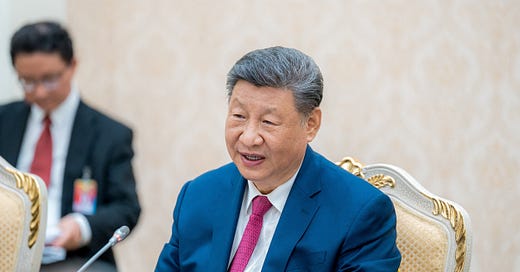China's Xi to Visit Shanghai
Xi Jinping Heads to Shanghai as China Faces High-Stakes Trade Tensions
Xi Heads to Shanghai as During China High-Stakes Trade Tensions
SHANGHAI, April 28— Xi Jinping Heads to Shanghai as China Faces High-Stakes Trade Tensions
Chinese President Xi Jinping is scheduled to visit Shanghai this week, according to two sources familiar with the matter, in a move seen as a direct effort to bolster confidence in China's primary international financial center amid intensifying pressure from the escalating U.S. trade war.
The trip, which includes a stop at Tesla’s largest global manufacturing site, comes as senior Chinese officials have ramped up assurances that the world's second-largest economy remains resilient, even as U.S. President Donald Trump’s tariffs—now standing at a 145% rate—threaten China’s critical export sector.
The Chinese government has not officially commented on Xi's planned visit. The State Council Information Office, responsible for responding to media inquiries, declined to confirm the sources' account.
Analysts suggest the optics of the visit are clear. Alfred Wu of the National University of Singapore noted that Xi is unlikely to address the trade war publicly, choosing instead to spotlight technological advancements such as the recent launch of Chinese AI startup DeepSeek. "Xi would not want to show any weakness," Wu said.
Meanwhile, global growth projections are deteriorating. The International Monetary Fund last week cut forecasts for China, the U.S., and most major economies, citing the toll from tariffs now at century-high levels.
Despite efforts over recent years to diversify away from reliance on U.S. markets, Chinese exporters have struggled to replace lost American demand with domestic or regional alternatives. Weak internal consumption continues to undermine Beijing's “dual circulation” strategy.
In retaliation for the latest wave of U.S. tariffs, China has imposed its own countermeasures, including restrictions on key exports such as rare earths—materials critical to global industrial supply chains.
While Washington has signaled a theoretical openness to de-escalation, fundamental disagreements remain entrenched. Trump claimed last week he and Xi had spoken by phone regarding tariffs; China's foreign ministry swiftly denied any recent communication between the two leaders.
Strategic Focus: Tech, Finance, and Employment
Xi’s last visit to Shanghai in November 2023 emphasized the city’s role as a global financial hub and a leader in technology development. That trip also included meetings with officials from the Yangtze River Economic Belt—a bloc that accounts for over 40% of China’s GDP and serves as a key artery for exports.
Analysts anticipate Xi may again prioritize globalization of the yuan and call for greater overseas financing to support Chinese firms expanding abroad. Dan Wang, China director at Eurasia Group, noted that Xi could also underscore the importance of sustaining manufacturing and employment: “The job losses in the region could be substantial if they lose half of their U.S. orders,” Wang said.
Chinese authorities continue to project confidence. Zhao Chenxin, vice chair of the National Development and Reform Commission, reiterated on Monday that China remains “fully confident” in achieving its 5% growth target for 2025. Zhao added that China can secure vital commodities—such as soybeans and energy supplies—without relying on U.S. imports if necessary.
The stakes surrounding Xi’s Shanghai visit are significant: reinforcing domestic confidence, projecting strength to global markets, and navigating the country through its most serious trade challenge since the start of the Trump tariffs era.





It is interesting that almost all of these articles about the Chinese decoupling from US supplies do not even investigate the infrastructure constraints that lock the Chinese into its US suppliers. Case in point is ethane, used by most of China's plastic manufacturers. The global ethane market is locked into long term contracts and the supply is constricted by the limited amount of VLECs (Very large ethane carriers) that are already chartered. Even if China can negotiate to buy someone else's long term contracts, China can not readily get VLECs prepositioned to transport the ethane to their markets. So China is locked into the US supplies or has to do without. There are many other such commodities that have this same set up. China weaning itself off of US ethane might take a year, if they are lucky, and probably several years. The US conversely, because much of its trade is consumer oriented and not industrial, has an easier time decoupling. This is not to say that the US is not locked into some Chinese industrial goods either, the US is highly dependent upon the Chinese to manufacture utility grade electrical transformers. So the sword cuts both ways.